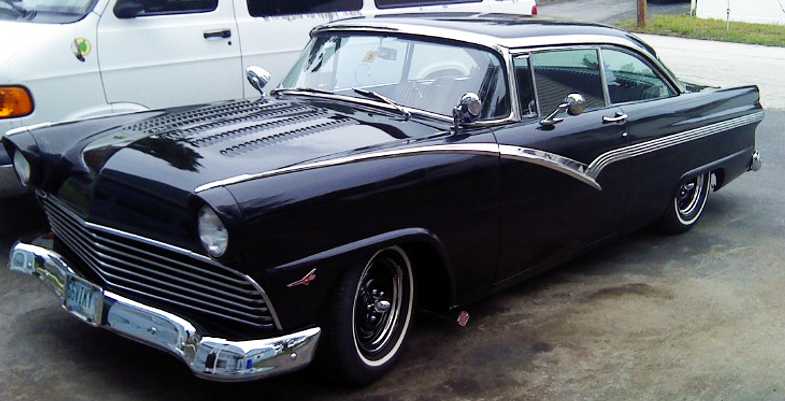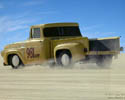|
Author
|
Message
|
|
MoonShadow
|
|
|
Group: Forum Members
Last Active: Yesterday
Posts: 4.6K,
Visits: 38.5K
|
That was the show I mentioned. Didn't recall the part about the closed tailgate phenomenom. Maybe that pickups have a unseen advantage with that bubble. I'd like to see a wind tunnel test of that and also what would happen if you changed the attitude of the roof line higher or lower in the back. Or a rearward tilt in the windshield etc. Can you do any custom ducting underneath or around the engine compartment to maximize air flow? Subtle changes could be made there possibly to help. Too bad wind tunnel time is so limited and expensive. Of course you LSR guys are so quick maybe you could make a scale model of the trucks and experiment with a homemade wind tunnel. Its been done before! Chuck
Y's guys rule!
Looking for McCullouch VS57 brackets and parts. Also looking for 28 Chrysler series 72 parts. And early Hemi parts.
 
MoonShadow, 292 w/McCulloch, 28 Chrysler Roadster, 354 Hemi)
Manchester, New Hampshire
|
|
|
|
|
57FordPU
|
|
|
Group: Forum Members
Last Active: 4 Years Ago
Posts: 726,
Visits: 73.6K
|
BTW Tim, thanks for letting us hijack your thread. All of the records that were set with the brick in 2008 were made with no bed cover and no tail gate. In 2009 I talked at length with Gail Banks about some of his wind tunnel testing that he did with his 200 mph GMC first gen mini pickup. He tried different bed cover lengths and said the best coefficient of drag (Cd) was obtained with the back 2/3rds of the bed covered and the tail gate up. He thought that with my full size pickup, the low pressure behind the cab would be greater than his and that with the taller cab I might try starting the bed cover at the middle and work forward. He also said to definitely have the tail gate up whether or not I ran a cover. Unfortunately, there were so many changes made to the brick in later events that it would be impossible to determine if the cover and tailgate up made any positive difference. However, you can bet I will have the Banks suggested bed cover and tailgate up on the new race truck. Chuck, all of your ideas make plenty of sense. Most are used in other classes, however, too bad none are available in production pickup. In addition, they are not allowed in my modified pickup class either.
Charlie Burns Laton, Ca (South of Fresno)

BurnsRacing981@gmail.com
|
|
|
|
|
pegleg
|
|
|
Group: Forum Members
Last Active: 4 Years Ago
Posts: 3.0K,
Visits: 8.7K
|
charliemccraney (9/15/2011)
I thought that I've read or heard somewhere that newer trucks are designed in such a way that it really doesn't make much difference whether the tailgate is up or down. This makes sense when the demanding economy requirements are considered. If this is true, then how applicable is it to a truck 40 or 50 years or older, when aerodynamics was of little concern? charlie, this is sheer guesswork on my part, but I suspect the results would be similar. The old trucks just had more frontal area. I think the relation ship to the bed would be about the same. Maybe less since the "stepside" style beds were smaller in relation to the size of the cab. Charlie and Tim could probably come close to an answer because their trucks represent two totally different styles. With known Hp and top speed you could calculate the (drag) cd.
Frank/Rebop Bristol, In ( by Elkhart) 
|
|
|
|
|
GREENBIRD56
|
|
|
Group: Forum Members
Last Active: 2 Years Ago
Posts: 1.7K,
Visits: 102.7K
|
In the earlier photo of Tim's truck - is the nose down due to rake or air pressure? Seems to me you would be better off with a "level deck" and some dead weight in the back - than a wedge. I drove my old '95 F-150 about 120,000 miles on business trips in Wyo, Montana and No Dakota. Not 135 mph - but often over 90 for long periods - and after trying all sorts of variations, I just quit trying. A "5th wheel" style tool box (flush with the bed rails ) and tailgate up were as good as anything else for mileage - so I just filled the two tanks and drove it. Did the plenum air source work OK for the carb? I saw a picture with the carb hat on there and a duct.

Steve Metzger Tucson, Arizona
|
|
|
|
|
glrbird
|
|
|
Group: Forum Members
Last Active: Last Year
Posts: 616,
Visits: 7.1K
|
Tim and Charlie Has anyone tested the difference in under hood air preasures with and without the inner fender wells in front?
Gary Ryan San Antonio.TX.
|
|
|
|
|
57FordPU
|
|
|
Group: Forum Members
Last Active: 4 Years Ago
Posts: 726,
Visits: 73.6K
|
Gary, The under hood air pressure management is really important. However, the rule book says "...pickups with full stock bed, unaltered in height, width, and contour, with all panels mounted in the original relationship to each other... They are pretty serious about this. They consider even the bed floor a panel. I once ran the exhaust up through the bed just behind the cab to blow holes in the low pressure area and the next year the rule book stopped that. In both production and modified pickup, there is no blocking of the grille. Some guys were blocking behind the radiator, but they stopped that too. My approach this time is to manage the air flow in the engine compartment by allowing the air to escape at the back of the hood into the low pressure area at the base of the windshield. You have seen the cowl vent hoods that are raised and open at the windshield area. I don't know exactly what my raised hood requirements will be with the turbos, but when finished, it will definitely be open at the rear. When the air has to slow down in any circumstance, it builds back pressure which will slow you down. I constantly think of ways to help channel engine compartment air to the windshield without slowing it down. Another problem is to also channel the air in such a way as to keep it from going under the race car at the bottom of the engine compartment. (no belly pans)
Charlie Burns Laton, Ca (South of Fresno)

BurnsRacing981@gmail.com
|
|
|
|
|
glrbird
|
|
|
Group: Forum Members
Last Active: Last Year
Posts: 616,
Visits: 7.1K
|
So are you saying that the front inner fender panel being removed (as in Tim's truck ) is better to let the air out and not trap it and maybe force it under the truck? Both of the trucks and the one you are building have been great to watch, I just was wondering.
Gary Ryan San Antonio.TX.
|
|
|
|
|
57FordPU
|
|
|
Group: Forum Members
Last Active: 4 Years Ago
Posts: 726,
Visits: 73.6K
|
First, I was trying to say they will not allow any changes to the inner fender panel, but yes, if you could remove them, it would greatly help lower the pressure under the hood. If the escaping air made it's way from the fender well area to underneath the truck, that would be a negative. Some kind of vent would be needed to allow the air to make it's way from the fender well area to the outside of the truck. Consequently, holes for vents in the fender to allow the channeled air to the outside would not be allowed either.
Charlie Burns Laton, Ca (South of Fresno)

BurnsRacing981@gmail.com
|
|
|
|
|
glrbird
|
|
|
Group: Forum Members
Last Active: Last Year
Posts: 616,
Visits: 7.1K
|
Charlie I'm not trying to beat a dead horse, but both the trucks "have" the inner fenders in place? I was going by some pictures on the thread and i thought they were "removed".
Gary Ryan San Antonio.TX.
|
|
|
|
|
57FordPU
|
|
|
Group: Forum Members
Last Active: 4 Years Ago
Posts: 726,
Visits: 73.6K
|
Gary, that makes plenty of sense. I too have seen those pictures and they were just progress pics during the build and now the inner fenders are in place. Yesterday Chuck mentioned something very important. Starting and staying on the good side of the tech inspectors is a must. Pre inspections at Elmo like Tim did before the truck was finished and answering questions truthfully sure greases the skids on future inspections. However, not all inspectors have the same view point. Just like the racers interpret the rules differently, so do some of the inspectors and from time to time, they have to huddle and come up with a group decision. At Bonneville last month I saw one entry get sidelined until a change was made. It seems one inspector didn't like having a rubber boot on a shifter. When asked by another inspector why they ruled that way, the inspector in question said, "Well, they wouldn't let me run my car with a rubber boot and this one will not either". The car was pitted next to us and when we found out, we did a little shopping for him as we needed something for Jake at the local parts store. We came up with a questionable solution with a leather glove. I don't recall, so Tim will have to comment as to whether they used it or not, but they did run and if they did use it, I bet I know which finger they used to slide down over the shifter.
Charlie Burns Laton, Ca (South of Fresno)

BurnsRacing981@gmail.com
|
|
|
|